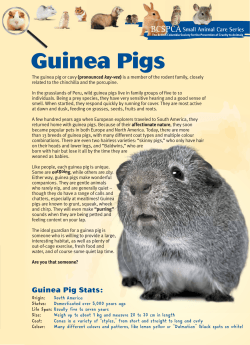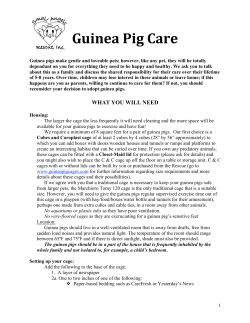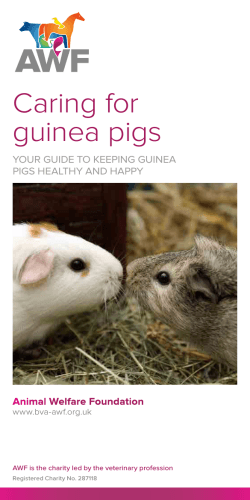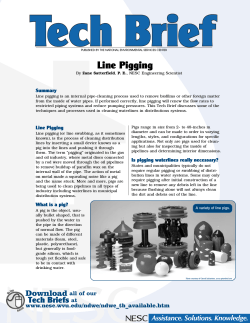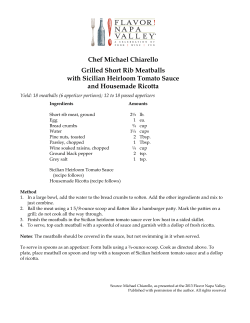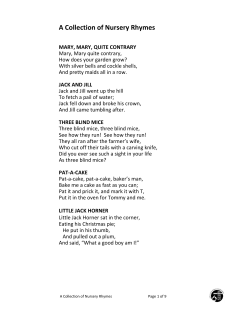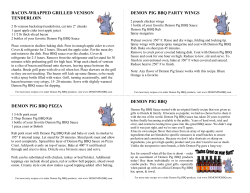
Guinea Pig New Owner Guide Written & Complied by AWLQ Education Division
Guinea Pig New Owner Guide Written & Complied by AWLQ Education Division ©Animal Welfare League Qld 2010 INTRODUCTION Congratulations on the adoption of your guinea pig! Here at the Animal Welfare League Qld, we are very proud of our Guinea Pig Adoption Program and the way in which our piggies are cared for and nurtured. Many guineas in our rehoming program have come to us in terribly neglected condition, with problems such as mites, vitamin C deficiency, hair loss, illness, pregnancy and worse! Most of the time, these problems are caused not from cruelty by their owners, but rather from simple neglect and lack of appropriate care, probably due to a poor understanding of what guinea pigs really need. Our staff and volunteers put a lot of effort into caring for our guineas, some needing weeks of nursing and feeding back to health before we are able to place them into homes. We have produced this guide in the hope that the high quality of care they have received whilst with us here at AWLQ, will continue when they go into their new home. In this guide, you will learn about feeding, grooming, handling and housing your guinea pig, as well as how to watch for signals that your guinea pig uses to communicate stress, illness, happiness, fatigue and hunger. The goal of this guide is to allow you to have a fulfilling and enjoyable relationship with your pet guinea pig and to ensure that they never come to be in the same sad situation that caused them to be with us here at the AWL in the first place. 2 | Guinea Pig New Owner Care Guide/Created Oct 2010/AWLQ Education Division/ File Location: My Documents/Zoe Files/Education/Guinea Pig Info HOUSING You need to be well prepared for the arrival of your new guinea pig. There are a number of things to think about. For example, where will you keep your guinea? What sort of cage will you provide for him? Do you have all of the necessary bedding, food, water, hiding places and toys for your guinea pig’s health and comfort? CAGE PLACEMENT Ideally, you should be able to move your guinea pig between an indoor and an outdoor environment. An indoor enclosure provides your guinea with security and warmth at night and during bad weather and an outdoor enclosure provides it with fresh air, grass and plants to munch on. You HELPFUL HINT must weigh up the risks that an outdoor cage Guinea pigs need at least two square poses, however. Temperatures ranging from feet of cage space including space for 18 to 25 degrees Celsius make the best their hiding places and food bowls. environment for a guinea pig. They are Each additional guinea pig needs and sensitive to heat and can die from heat stroke, extra two to four square feet. so if you do decide to build your guinea a hutch outdoors, always remember that Australian summers get extremely hot and the last thing you want is for your new friend to die from heat exposure! Hutches and cages, wether out or indoors, should be well-constructed and keep your guinea safe from predators such as cats, dogs and birds of prey (outdoors). If keeping your pet indoors, please AVOID the following rooms and spaces: The laundry room The constantly shifting temperature and humidity can make your guinea pig sick. Ask yourself, is the laundry room the kind of place that family members would like to hang out and play with the guinea pig? The answer is usually no. The garage This is not much better than living outside and guinea pigs rarely Above: This is just one style of guinea pig/rabbit hutch that you receive the love and attention they need can purchase from pet or produce stores. Also, check out EBay. when they live in the garage, even if it is attached to the house. Closets, bathrooms, pantries, basements etc. Ask yourself, would I keep my puppy, or my kitten in a closed, dark space? No, of course not. Guinea pigs need to be in a bright, open area where family members can play with them and pet them frequently. 3 | Guinea Pig New Owner Care Guide/Created Oct 2010/AWLQ Education Division/ File Location: My Documents/Zoe Files/Education/Guinea Pig Info A child’s room The reason for this is that most children are not responsible enough to clean bedding twice a week, maintain food and water and pay attention to a guinea pig consistently. You know your child better than anyone else, however. If you are confident that he or she can truly give a guinea pig what it needs to be healthy and happy, then by all means, set up the cage in the child’s room. HELPFUL HINT Check out Cavycages.com. This Never use an aquarium to house a guinea pig. The Internet site includes clear ammonia fumes from their urine will make them ill instructions on how to build a unless they are in a well ventilated cage. It is just spacious cage for your guinea human nature to avoid doing things that are difficult pig for little money. or inconvenient. Therefore, make sure that the cage that you buy and the area in which you place it are easy for you to access regularly. There is nothing sadder than a neglected, forgotten about pet and this happens all too often to guinea pigs, as they are not demanding of attention like cats and dogs. We advise keeping your new pet in a common family area such as a family room or game room where adults can observe that the animal is receiving adequate care. BEDDING AND CAGE CLEANING Bedding is what you lay on the bottom of the cage. In general, it’s a good idea to line the cage with newspaper and then place the bedding over the top. This helps make the cage easier to clean and protect the bottom of the cage or hutch from urine and droppings. Hay and wood shavings make ideal bedding and are relatively cost effective. You will need to change the bedding about two or three times a week, depending on how many guinea pigs you have. As long as you change the bedding frequently, your guinea cage will not smell. After removing and discarding all the bedding and newspaper, wipe out the cage with some warm water and a mild detergent solution or spray made up of three parts water, one part vinegar. Whatever cleaning agent you use, be sure it is mild and free of harsh chemicals. Above: wood shavings make ideal bedding for a guinea enclosure. 4 | Guinea Pig New Owner Care Guide/Created Oct 2010/AWLQ Education Division/ File Location: My Documents/Zoe Files/Education/Guinea Pig Info CAGE ACCESSORIES Your guinea needs hidey holes and interesting spaces to explore to its enclosure. You can purchase small animal ‘igloos’ from pet stores (pictured left), but there really is no need to spend lots of money - it is simple enough to make interesting spaces from everyday household objects and recycled materials. Here are some ideas for hidey spaces and toys that your guinea will love: Small cardboard boxes (like shoe boxes) with ‘doors’ cut into them PVC pipe cut offs Used toilet rolls (with grass or hay stuffed inside) Tennis balls and ping-pong balls Old kids’ toys (anything that could potentially make a nice hiding place - make sure it has no sharp edges or stuffing Above: Give your guinea lots of fun hiding places. that your guinea may want to eat!) DIET FRUIT & VEGETABLES Guinea pigs are herbivores (vegetarian), which means they don’t eat fish or meat. Along with humans and monkeys, guinea pigs cannot manufacture their own vitamin C, their bodies cannot produce it. Because of this, vegetable matter is an essential part of a guinea pig’s diet. The easiest way to achieve this is to feed your guinea pig plenty of vegetables and fruit daily. Most of the fresh produce we eat is ideal for your guinea pig, see the table on the next page: Above: Make sure your guinea has her daily feed in a bowl that she can’t tip over! 5 | Guinea Pig New Owner Care Guide/Created Oct 2010/AWLQ Education Division/ File Location: My Documents/Zoe Files/Education/Guinea Pig Info Vegetables Celery (with leaves) Radish Cucumber Carrots Tomatoes Capsicum Cabbage Cauliflower Spring Greens Spinach Snow Peas Corn on the Cob (in the husk) Fruit Banana Pears Apple Grapes Paw Paw Watermelon Kiwi Fruit Strawberries Fresh Herbs Parsley Coriander Rocket Leaves Watercress Basil Chives Guinea pigs will have their individual tastes so don’t expect each one to like the same. This is why it is essential to give a wide choice. After time, you will get to know the food your Pig likes and dislikes. Give about a large handful for each guinea pig. All fresh food must be served at room temperature. Chilled or frozen produce can upset a guinea pigs stomach and cause diarrhea. The following foods are toxic to guinea pigs and/or will give them an upset stomach and potentially make them seriously ill. These foods are to be avoided totally: Iceberg Lettuce Daisies Sultanas Rhubarb Buttercups & daffodils Green Beans Tomato Leaves Seeds & nuts Dairy Products Mushrooms Chocolate Bread GRASS & PLANTS A favourite food for guinea pigs is fresh grass. Ensure that any grass is free from pesticides, dog fouling and toxic plants. It is best to restrict grazing time on new spring grass because too much can cause diarrhea. Do not feed grass cuttings as these can cause digestive problems. Dandelions are also a favourite, but only give a few of these as they can also cause diarrhea. Above: Hay stuffed inside an empty toilet roll makes for a good ‘food enrichment’ toy for your Guinea 6 | Guinea Pig New Owner Care Guide/Created Oct 2010/AWLQ Education Division/ File Location: My Documents/Zoe Files/Education/Guinea Pig Info Wild edible plants can be gathered. It is best to invest in a well illustrated handbook but unless you know exactly what you are doing, play on the safe side: if in doubt leave it out. Guinea pigs like to eat more or less constantly so it is essential they have something to nibble on such as hay. Hay is essential for guinea pigs; it provides roughage, and aids digestion. The hay should be good quality ‘Grassy’ or ‘Barley’ hay; preferably spore free treated and purchased from a good produce store. Poor hay is detrimental to the guinea pigs health if it is dusty, mouldy or has fungal spores. DRY MIX Never feed a guinea pig on dry mix that contains EC permitted chemical colorants. Read the contents listed on the packet carefully. It is best to choose a good quality mix that has no colorants added. Such a mix will usually contain grains, flakes and pellets. The best type of dry mix for adult guinea pigs is ‘Oaten Chaff’, available in bulk from produce stores. All dishes used for guinea pigs should be clean, washed daily and non tip-able. The guinea pig is a creature of habit, so establish set times for feeding: • Morning dry mix, hay and dried grasses HELPFUL HINT Rabbit mix is not suitable for guinea pigs, as it does not contain Vitamin C. Rat/mouse mix is also unsuitable as this contains peanuts and sunflower seeds. Peanuts are fattening and sunflower seeds are harmful in large quantities. • Late afternoon fresh produce • Bedtime more dried grass to nibble on throughout the night Last of all it is important that guinea pigs work for their food; they are equipped with constantly growing teeth so hard food and roughage is a must! WATER Your guinea pig should always have access to fresh water in a bottle attached to the side of the hutch, such as the one shown in the illustration. Check the water at least once daily. Water in a bowl in the hutch will get soiled very quickly or tipped over, leaving the guinea pig without water, so this is not a good idea. Above: Make sure you attach the water feeder securely to the side of the cage and check the levels every day. 7 | Guinea Pig New Owner Care Guide/Created Oct 2010/AWLQ Education Division/ File Location: My Documents/Zoe Files/Education/Guinea Pig Info GROOMING TEETH Above: Guinea pig teeth grow constantly, so they need to chew to keep them trim. Guinea pig’s front teeth grow constantly; unless the animal keeps the teeth pared down by chewing on hard things like carrots, turnips, chew sticks, branches or wooden blocks, they will grow so long that it hurts it to eat, and then it will stop eating altogether. Each week, check to make sure that your pet’s teeth are not growing inward or getting too long. If you see that this is happening, then take them to your vet to have their teeth trimmed. Also keep in mind that if a guinea pig is not getting adequate nutrients, its teeth may break off. A trip to the vet would be needed if this happened as well as extra care with feeding until the teeth grew back. HAIR Long-haired guinea pigs need to be brushed on a daily basis or else the hair will become so tangled it may need to be shaved. Long hair grows about one inch a month, so a bi-monthly trimming is also important to do. Just cut the hair short enough that is does not get in the way of the guinea pig’s normal movement. It’s also a good idea to trim around the bottom area so it doesn’t get mucked up with faeces and urine. Short-haired guinea pigs will only need to be brushed every couple of weeks. This will get rid of any dead hair and keep your guinea looking sleek and clean. Above: Long haired breeds need brushing every day to avoid matting. NAILS In the wild, a guinea pig’s nails naturally file down with wear, however, in captivity this does not happen. Just as with dogs and cats; nails that are too long can cause injury and pain to your pet and to you (when you are cuddling it). Ask your vet or professional groomer to teach you how to clip your guinea’s nails. This is very important because guinea pig nails contain blood vessels and if you Left: Nails can become deformed if left unclipped. 8 | Guinea Pig New Owner Care Guide/Created Oct 2010/AWLQ Education Division/ File Location: My Documents/Zoe Files/Education/Guinea Pig Info cut them too short, your guinea pig will bleed. It is not easy to hold a guinea pig still long enough to cut its nails and they don’t like it very much, but if it concerns you, have a vet demonstrate some holds that make this easier. BATHING Guinea pigs don’t like to get wet and baths make them very nervous. Only if your cavy has lice or has gotten into something truly messy should you try to bathe them. If you do need to bath your guinea, make sure you are well prepared before you begin by gathering the following items: A shallow wash tub (or you could use the bathroom or laundry sink) A mild shampoo such as baby or kitten/puppy shampoo A soft towel for drying the guinea pig A heater if the room or temperature is slightly chilly Guinea pigs have very sensitive skin so make sure that the water is just warm but not hot. Put about two inches of water into the tub/basin. Above: Take care when bathing your guinea pig as they are extremely sensitive to the cold. Pour a little water over the guinea pig to get it wet and then with a little dab of shampoo lather her fur from the rear to the head, avoiding the face and eyes. Rinse by pouring water along the animal’s neck, so it stays out of her face and eyes. Make sure that all of the shampoo is thoroughly rinsed out and then gently pat the guinea pig dry with a towel. Under no circumstances should you use a blow dryer on a guinea pig. Her skin is very sensitive and a blow dryer could burn it badly. Unless it is absolutely necessary, try not to give your guinea a bath during the winter. A wet guinea pig can get sick much more easily than a dry one, especially in cold temperatures. Nursing, pregnant or baby guinea pigs (under two months old) should never have a bath. Left: Make sure you are well prepared before you begin the bath! 9 | Guinea Pig New Owner Care Guide/Created Oct 2010/AWLQ Education Division/ File Location: My Documents/Zoe Files/Education/Guinea Pig Info HEALTHCARE The best healthcare for your guinea pig is PREVENTATIVE health. This means preventing problems from happening by keeping him on a good, well balanced diet and checking him regularly for abnormal behaviour and or signs of illness, disease or parasites. Keeping a close eye on your guinea pig and giving him quality care as you would any other member of your pet family, should hopefully help you avoid expensive veterinary bills! Be sure to establish that your vet has experience treating small animals, as not all vets know a great deal about guinea pigs. PARASITES AND DISEASES Lice and mites live in guinea pig hair and skin. Check their scalp and skin for signs of lice, which look like tiny white worms. Mites show up as small bumps along strands of hair. Ordinary fur mites are relatively harmless, though they do cause itching and eventual scratching that might make hair fall out. When faced with this sort of problem, bath your guinea in ‘Malesab’ shampoo (available from pet stores) and follow the bathing instructions in the previous chapter. Bathe all of your guinea pigs even if only one of them shows signs of lice or mites. Also, clean out the cage thoroughly. Above: Hair loss due to an infestation of mites ‘Revolution’ is a product used to treat cats and dogs for mites, lice and fleas. You can keep mites off your guineas by treating them with Revolution used for puppies and kittens, available from pet stores and vets. Just follow the instructions as you would if you were treating a kitten. SIGNS OF ILLNESS In the wild, predators are quick to kill sick and injured guinea pigs. As a result, guinea pigs have learned to hide the fact that they are sick. You will have to keep a close eye on your guinea pig’s general wellbeing, otherwise by the time you realize that the animal is ill, it may be too late. The following chart may help you assess whether you need to take your guinea pig to the vet or it is something that can be treated at home: Above: Sick guinea pigs hide it well, so keep a close eye on your pet; especially if there is a sudden change in behaviour. 10 | Guinea Pig New Owner Care Guide/Created Oct 2010/AWLQ Education Division/ File Location: My Documents/Zoe Files/Education/Guinea Pig Info GUINEA PIG REPRODUCTION Allowing your guinea pig to reproduce is not only unethical - it is also extremely dangerous for the birthing female (called a sow). There is no need to bring more baby guinea pigs into the world when so many pet guineas languish in shelters and pet shops unwanted. If you are desperate to care for baby or pregnant guinea pigs, then contact a guinea pig IMPORTANT WARNING shelter and see if you can foster a mum and babies. A female guinea pig cannot be younger Not only would you be helping out the shelter than four months or older than eight staff, you would also be helping care for a months when she is first impregnated. guinea pig that is most in need. After eight months, her hip bones fuse It is important to also keep in mind that breeding guinea pigs always puts the mother’s life at risk. Studies show that twenty percent of all guinea pig pregnancies are fatal for the mother and her babies. 11 | Guinea Pig New Owner Care Guide/Created Oct 2010/AWLQ Education Division/ File Location: My Documents/Zoe Files/Education/Guinea Pig Info together creating a dangerous situation that may require a caesarian section and/or lead to death of her and the babies! GENDER MIXING While both male and female cavies make great pets, you MUST know what the gender is of each guinea pig before you buy it. This is of the greatest importance, as you do not want your guinea pigs to fight and least of all, you don’t want any unwanted litters! Two mature males will fight for dominance, so the main thing to remember is not to put two mature males together. Even if one or both males have been desexed, they may still fight. The second thing you want to watch out for is putting a fertile male in with a fertile female. If you want to keep a male and a female together, you must have the male desexed. Keep in mind that it is a far easier operation to have a male desexed than a female. Above: A sensible mixing of guinea pigs can create a harmonious ‘herd’. Perhaps the best and easiest pairing of guinea pigs is two females. While they may squabble at first and from time to time over food and water, they will generally get along pretty well. A group of females can also easily get along with a neutered male. Some people advise placing a young male guinea pig in with an older male. This situation may be peaceful for a while, but when the young male reaches adolescent maturity, you may have a war on your hands. Whenever you add a new guinea to your guinea pig’s home, expect that they will tussle among themselves until they have established dominance. After that, they will usually become good friends. PREGNANCY If by chance your guinea pig does fall pregnant, or you happen to adopt one that is already pregnant (which is a fairly common occurrence; especially from pet stores), you should take extra care to nurture your expectant mum. If you think that your guinea pig is pregnant, take her to the vet right away. The vet will confirm or deny the pregnancy and give you an estimated due date. Gestation is only sixty or seventy days, so you don’t have much time to prepare if she is carrying babies. Above: A very pregnant guinea pig! 12 | Guinea Pig New Owner Care Guide/Created Oct 2010/AWLQ Education Division/ File Location: My Documents/Zoe Files/Education/Guinea Pig Info Guinea pigs usually have litters of two to four pups. Prepare to give your pregnant mum more fresh produce, as she will be eating for herself and her babies. Also, plan on providing her with extra Vitamin C and fruits or fruit juice; this extra sugar prevents the female from developing a condition called toxemia. Toxemia can be fatal to the mother and result in miscarriage and stillbirth. Keep the pregnant female as stress-free as possible, separating her close to the time of delivery. It’s hard to say exactly when a guinea pig is going to give birth. You may notice that your pet is moving about less and interacting less. This usually happens about one or two weeks before she goes into labor. The whole birthing process only takes between fifteen and forty minutes. If you are present when she goes into labor, you will see her ‘hiccupping’ or experiencing pre-labor pains. With each contraction she will hunch up and then reach under her and grab the baby. The mother bites through the umbilical cord and cleans the embryonic sac off of the baby’s face. Four or five minutes later, the next baby should come out. If your pet begins to squeal in pain, bleed or collapse due to exhaustion then rush her to the vet. Never, never try to deliver the babies yourself! Born with fur, teeth and nails, guinea pig pups will be exploring their new home with open eyes two hours Above: A one-week old guinea pig. after being born. Within twenty-four hours they will begin to eat hay, fresh produce and feed like their parents. Every two hours or so they will drink milk from their mum. Guinea pigs wean from their mother after three or four weeks of life. After three or four weeks the pups will be independent of their mother and it is at this time that you must separate the males from the females. The females will have reached sexual maturity and the mother will also be able to become pregnant, so it is vital that all males be removed from the same cage as the females. 13 | Guinea Pig New Owner Care Guide/Created Oct 2010/AWLQ Education Division/ File Location: My Documents/Zoe Files/Education/Guinea Pig Info GUINEA PIG BEHAVIOUR Like any pet, a guinea pig is a big commitment. Before you take on this four to seven year responsibility you will want to learn about the general behaviour and temperament of guinea pigs. They certainly are interesting little characters, each with individual and distinct personalities that can be very amusing and entertaining! COMMUNICATION The sounds that a guinea pig makes are quite distinct and fun to learn. Here are seven of the most common. Note that some sounds are accompanied by specific body language as well. Low rattling sound – This deep, constant sound signals to the guinea pigs of the opposite sex that he or she is ‘in the mood’. Also, if you have two or more female guinea pigs, you may hear this noise when the dominant pig greets the others. Rumbling sound – This sound is a signal that your guinea pig doesn't like something. If you are petting him, then that means it doesn't Above: A relaxed guinea resting in the grass feel comfortable with how you are touching him. If he is alone in his cage, it might mean that there's a loud sound he doesn't like. Squeals/Whistles – Normally, this sound is never used with other guinea pigs. The animal has developed it for one purpose: to ask humans for food. Clacking teeth – If you have several guinea pigs in a cage together, you'll definitely want to listen for this sound, which is a warning and a signal of aggression. Shrieks – Guinea pigs make this sound when they feel afraid, lonely, or in pain. If your pet makes it then you need to figure out why and resolve the situation, so your guinea pig can return to being happy. Grunts/Squeaks/Chirps – You'll (hopefully) become all too familiar with these noises, since the guinea pig uses them to let you know he's happy and comfortable. It's also the basic sound used between guinea pigs as they communicate with one another. Purrs – These soft sounds may remind you of a cat as it rubs on your leg, and both the cat's and the guinea pig’s sound means pretty much the same thing: they like whatever you are doing a lot! 14 | Guinea Pig New Owner Care Guide/Created Oct 2010/AWLQ Education Division/ File Location: My Documents/Zoe Files/Education/Guinea Pig Info HANDLING YOUR GUINEA PIG Often, a child’s natural inclination is to grab a guinea pig around its middle, or lift it by its feet, which could injure your guinea pig. The best way to pick up your pet is in a cradle-like manner. Put one hand against the chest and with the other hand gently cup their rear. Now, slowly lift the guinea pig out of its cage and then place it on your lap, on the floor or against your chest. As long as the guinea pig is near you or its feet are on something solid, it feels safe. If your guinea pig wiggles and squirms that means it is scared and you are probably not holding it correctly. Above: This guinea would not be feeling very safe right now! Left: This guinea would be feeling very safe right now! 15 | Guinea Pig New Owner Care Guide/Created Oct 2010/AWLQ Education Division/ File Location: My Documents/Zoe Files/Education/Guinea Pig Info
© Copyright 2025
